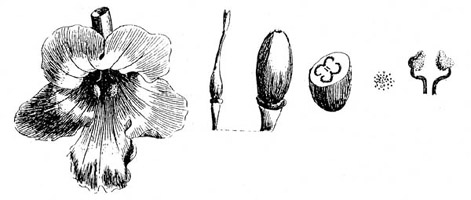
J.R. & G. Forster, Char. gen. 6, t. 3 (1776), orig. illustration
Full name and orig. publication: Cyrtandra J.R. & G.Forst., Char. gen. pl. 5 (1776).
Etymology: From the Greek κυρτος, kyrtos = curved, tortuous, and ανδρος, andros = male, alluding to the curved filaments of the stamens.
Synonyms: Rhynchocarpus [Reinw. ex] Blume (1823), Whitia Blume (1823), Getonia Banks & Sol. (1838), Cyrtandropsis Lauterb. (1910), Protocyrtandra Hosok. (1934), Cyrtandroidea F.Br. (1935), ? Sepikea Schltr. (see there).
Infrafamilial position: Didymocarpoid Gesneriaceae - "Advanced Asiatic and Malesian genera" (Weber 2004).
Description: Shrubs or lignescent herbs, sometimes small trees. Stem terete or angular, usually erect or ascending, branched or unbranched. Leaves opposite, iso- to strongly anisophyllous; petiole short to long, lamina of variable shape, ranging from narrow lanceolate to suborbicular, margin entire or dentate, venation pinnate. Cymes axillary, shortly to long pedunculate, placed in upper or lower (leafless) part of stem, sometimes growing underground; bracteoles free, sometimes connate and forming a conspicuous cup; flowers in dense clusters or in open cymes or solitary. Sepals 5, free or connate, calyx sometimes bilabiate, persistent or caducous. Corolla variously (usually light-)coloured, funnel-form, campanulate or tubular, limb bilabiate, rarely (sub)regular, lobes rounded. Stamen usually two, the anterior ones, rarely 4 (the former genera Protocyrtandra and Cyrtandroidea) included or (rarely) exserted; anthers free or coherent, thecae subparallel, sometimes apically confluent, dehiscing longicidally; staminodes 2-3. Nectary ring- or cup-shaped, often persistent in fruit. Ovary ovoid to oblong, unilocular, placentae recurved; style long or short; stigma capitate or bilobed. Fruit indehiscent, oblong, ovoid or globose, hard-walled (sclerocarpous), leathery or fleshy.
Chromosome number: 2n = 34 (rarely 32?).
Species number: Between 450-600.
Species names (incl. publication and synonyms): See Skog, L.E. & J.K. Boggan. 2005: World checklist of Gesneriaceae: http://persoon.si.edu/Gesneriaceae/Checklist.
Type species: Cyrtandra biflora J.R. & G. Forst.
Distribution: Ranging from the Nicobar Islands and S Thailand through Malesia and the S Pacific to the Hawaiian Islands.
Ecology: Terrestrial plants of lowland and montane rain forests.
Notes: : The
northernmost outlier of the genus is C. umbellifera (Southern Ryukyo
Islands, Taiwan, Philippines). Centres of diversity are Borneo, New Guinea and
the Pacific Islands. Cyrtandra is the largest genus of Gesneriaceae and
the genus with widest distribution in the Old World. The main distinctive
character is the indehiscent fruit, which is hard as stone (sclerocarpous)
predominantly in the Western species and soft-fleshy (a true berry) in the
eastern (Pacific) species. A conspicuous anatomical character of many species is
the presence of sclereids (osteo- and/or astrosclereids) in the hypodermis and
mesophyll of the leaves. There is a continuous range from iso- to extreme
anisophylly (the smaller leaf of a pair being reduced to a tiny, triangular
scale, e.g., C. dispar, C. baileyi). In the inflorescences the
flowers are usually densely aggregated, and the bracteoles are sometimes
enlarged and fused to form a conspicuous cup. Sometimes the flowers are placed
at the ground by the elongation and downcurving of the peduncle or emerge from
the soil in that the elongated cyme is buried in the ground (geoflory; some
species from Borneo and Sulawesi, e.g., C. rhizantha). The usually
light-coloured flowers indicate melittophily; species with red or reddish flower
colour (e.g., C. clarkei) are possibly ornithophilous. Nothing is known
about the dispersal of the sclerocarpous fruits, while the fleshy berries are
clearly bird-dispersed. Cyrtandra is polymorphic throughout its range and
species delimitation is very difficult. Especially in the Hawaiian Islands
variation is extreme. This led St. John (Phytologia 63-65: 1987-1988) to
describe more than 250 new species, while a more realistic total species number
in Hawaii is around 60. The extreme polymorphism is the result of extensive
interspecific, and usually intersectional, hybridisation (Wagner & al. 1990,
Smith & al. 1995). A natural subdivision has not been achieved yet. Clarke
(1883) subdivided the genus (with 157 species then known) into two subgenera and
13 sections:
(A) subg. Brachycyathus (1) sect. Dispares, (2) sect.
Whitia, (3) sect. Stellatae, (4) sect. Cupreatae, (5) sect.
Apertae, (6) sect. Macrosepalae, (B) subg. Cytrandra
("Macrocyathus") (7) sect. Campanulaceae, (8) sect. Decurrentes,
(9) sect. Jackianae, (10) sect. Dissimiles, (11) sect. Coccineae,
(12) sect. Aureae, (13) sect. Polynesieae. With regard to the
Hawaiian species Wagner & al. (1990) recognized the following sections: (1)
sect. Verticillatae, (2) sect. Cylindrocalyces, (3) sect. Crotonocalyxes,
(4) sect. Apertae, (5) sect. Macrosepalae, (6) sect. Chaetocalyces.
A more natural subgeneric classification of the genus as a whole is badly
needed. A new section, Pleuroschisma, was recently established by
Hilliard et al. (2003). Sect. Dissimiles was recently revised by Bramley
(2005). Many species from Borneo have been and are being continuously described
by O.M.Hilliard and B.L.Burtt in Edinburgh J. Bot.
Selected references: C.B.Clarke in A. & C. DC., Monogr. phan. 5(1): 201-287 (1883), rev.; Bokhari & Burtt, Notes Roy. Bot. Gard. Edinburgh 30: 11-21 (1969), anat.; Burtt, Edinburgh J. Bot. 47: 201-233 (1990) and 49: 285-296 ([1992] 1993), new spp.; Backer & Bakh.f., Fl. Java 2: 543 (1965), reg. rev. (Java); Gillett, Contr. US. Natl. Herb. 37: 107-159 (1967), reg. rev. (Fiji); Gillett, J. Arnold Arbor. 54: 105-110 (1973), reg. rev. (Ryukyu and Caroline Islands); Gillett, Univ. Calif. Publ. Bot. 66: 1-59 (1973), reg. rev. (South Pacific); Roelofs, Pacific Sci. 33: 223-231 (1980), repr. biol.; St. John, Bernice P. Bishop Mus. Bull. 229: 1-465 (1988), reg. rev. (Oahu); Wagner, Herbst & Sohmer, Manual of Flowering Plants of Hawaii 1: 735-781 (1990), reg. rev. (Hawaii); Samuel, Pinsker & Kiehn, Bot. Acta 110: 503-510 (1997), molec. syst.; Wang et al. in Wu & Raven, Fl. China 18: 395 (1998) (Chinese spp.); Atkins et al., Biol. J. Linn. Soc. 72: 143-159 (2001), molec. syst. of Bornean & Philipp. spp.; Burtt, Phytomorphology, Golden Jubilee Issue 2001: 393-404 (2001); Burtt, Thai Forest Bull. (Botany) 29: 81-109 (2001), annot. checklist (Thailand); Hilliard, Burtt, Bokhari, Garden's Bull. Singapore 55: 35-60 (2003), new sect.; Bramley, Blumea 50: 163-189 (2005), rev. of sect. Dissimiles.
Bibliography: See Skog, L.E. & J.K. Boggan. 2005. Bibliography of the Gesneriaceae. 2nd edition: http://persoon.si.edu/Gesneriaceae/Bibliography.
Illustrations:
 |
Cyrtandra biflora J.R. & G. Forst.
J.R. & G. Forster, Char. gen. 6, t. 3 (1776), orig. illustration |
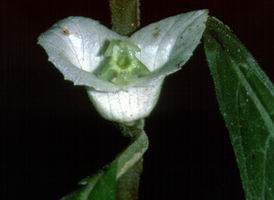 |
Cyrtandra burbidgei C.B.Clarke
Borneo, Sabah, Mt. Kinabalu, phot. S. Vogel (1979) |
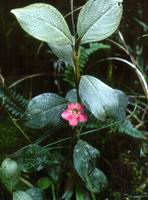 |
Cyrtandra clarkei Stapf
Borneo, Sabah, Mt. Kinabalu, phot. A. Weber (1979) |
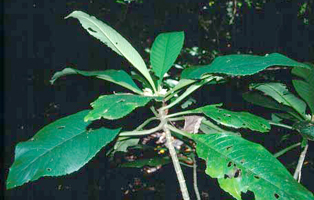 |
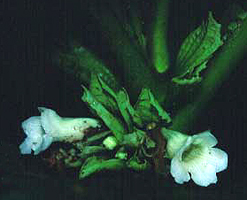 |
Cyrtandra cumingii C.B.Clarke
Left: Japan, Okinawa, Urauchigawa River, det.
& phot.
G. Kokubugata (1999) |
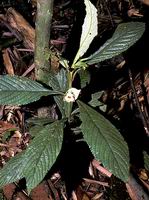 |
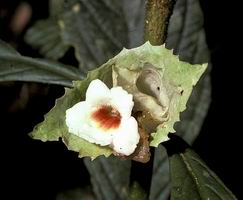 |
Cyrtandra cupulata Ridl.
Penins. Malaysia, Ulu Langat, phot. A. Weber (1984) |
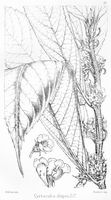 |
Cyrtandra dispar DC.
C.B.Clarke in A. & C.DC., Monogr. phan., t. 23 (1883) |
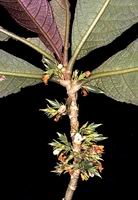 |
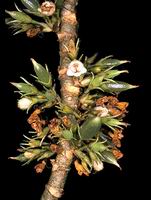 |
Cyrtandra dispar DC.
Penins. Malaysia, Gunung Keledang, phot. A. Weber (1986) |
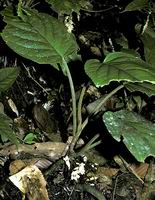
|
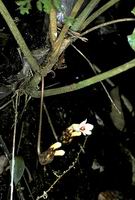 |
Cyrtandra pendula Blume
Penins. Malaysia, Jeram Toi, phot. A. Weber (1986) |
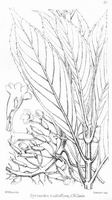 |
Cyrtandra radiciflora C.B.Clarke
C.B.Clarke in A. & C.DC., Monogr. phan., t. 28 (1883) |
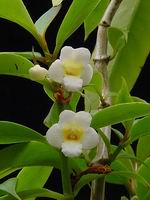 |
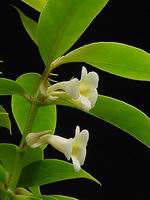 |
Cyrtandra sp.
Cult. BG Heidelberg, phot. A. Igersheim (2002) |
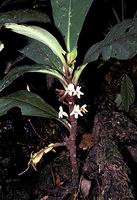
|
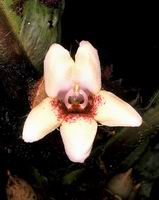 |
Cyrtandra wallichii (C.B.Clarke) B.L.Burtt Penins. Malaysia, Fraser's Hill, phot. A. Weber (1984) |
last modified: 2007-07-13